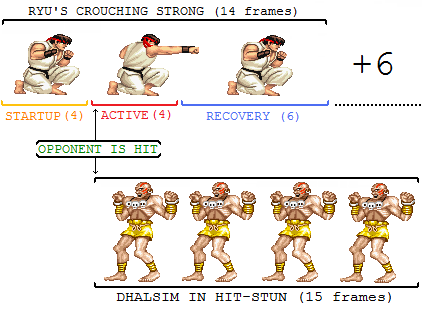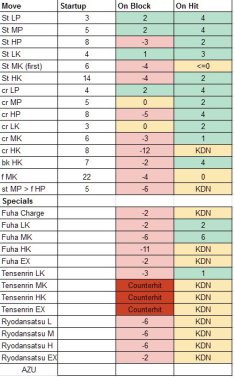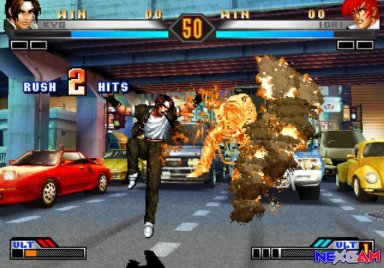
(UPDATE: Part 2 of the frame data sub-series of posts is now live. Click here to learn more about frame advantage!)
When most people play fighting games, they don’t think about the underlying mechanics that drive the on-screen action. Odds are, all they care about is whether or not they’re beating their opponent to a pulp. That’s all well and good. However, competitive fighting game players will go to great lengths to find any sort of advantage on their opponents. This can include learning advanced combos, specific tactics, or as deep as understanding the raw mathematics that drives how a fighting game works.
Yes, I did say mathematics. You see, behind the action are a series of mathematical constants, variables and calculations that drive how everything works. Most people never think about this side of a fighting game (or any game for that matter), but the math is there, whether you actively recognize it or not.
In this entry into the Universal Fighting Game Guide, let’s take a high-level stab at talking about one element of the math that drives a fighting game, which is frame data. Certain off-the-shelf guides will contain frame data for your game of choice, though online sites will likely be your best bet to find this type of information. To the untrained eye, frame data charts look like rocket science. If you’ve never tried to read frame data (or have attempted it and failed), this crash course in the basics may help.
What is a frame?
A frame, in the context of video games, refers to a frame of animation. If we were to analyze this static King of Fighters image above, it would count as 1 frame of animation.
What is frame rate?
Frame rate refers to the rate of frames of still images displayed in a fast sequence to create the sense of animation. Frame rate is measured in frames per second, ie. the number of frames of animation that are displayed in a second.
Movies and television usually run at one of three standard frame rates: 24 frames per second, 25 frames per second or 30 frames per second. Most modern fighting games run at 60 frames per second. This means that in a fighting game that runs at 60 frames per second, the time it takes for one frame of animation in a fighting game to complete is 1/60th of a second.

What is frame data?
Frame data is the information pertaining to the frames of animation of any given move, as well as the properties of that move on any given frame. The majority of frame data guides will include the frame data for every single move in a fighting game.
Why is frame data important?
Whether you want to crunch the numbers or not, frame data is one of the key elements that drives how a game works. Without knowing it, you probably already use your sub-conscious knowledge of frame data to determine the best course of action. If you at least understand the high-level concepts of frame data, you’ll be better understand how the game works, why certain things play out the way they do and how to use frame data to your advantage.
The phases of a move, as determined by frames
The life-cycle of a move is relatively short. Most of the time, we’re talking about fractions of a second. However, every move has a number of different phases it goes through as it animates from beginning to end. Every fighting game will have some unique variables and phases, but the following phases are standard across all fighting games. Please note that these three phases are usually labeled as such in any given frame data guide, though the language may vary.
Start-up
When you press a button to activate a move, your character will begin to initiate that move. The phase from when the move starts to when the move is able to hit your opponent is known as start-up. The general rule of thumb with fighting games is that the stronger the move, the longer the start-up for that move will be. Case in point, the Balrog video above. Balrog’s crouching light punch has very few frames at start-up, which means his move gets to phase where that punch can hit his opponent very quickly. However, his other normal moves or special moves would take more frames before they would be able to connect.
Active
The active phase of a move is the period of time in which the move is able to hit your opponent. Back to Balrog’s jab as an example. The active phase of Balrog’s crouching light punch contains very few active frames, which means the window of opportunity for that move to connect is very short. On the opposite end of the spectrum, a move like virtually every ultra combo in Street Fighter IV, which usually contain a series of moves, will have more active frames.
Recovery
The recovery phase of a move happens directly after the active phase is complete. This is the time when your character is recovering from the move they’ve done and returning to a neutral state. As with the start-up phase, the general rule of thumb is that the stronger the move, the more recovery required to return to a neutral state.

The classic recovery example is Ken’s uppercut. If you land it, you set your opponent ablaze with three hits of flaming fist goodness. If you miss, you’re forced to sit through a ton of recovery frames, where Ken is sailing into the air and falling to the ground. During that recovery period you’re open to get hit by your opponent.
Example of the three phases, as you’d see them in a guide

Those three phases (start-up, active and recovery) make up the core life-cycle of any given move. Each phase has a number of frames associated with it. If we were to look up Ryu’s crouching medium kick in a Street Fighter IV frame data guide, it would look something like the table below:
| MOVE | START-UP | ACTIVE | RECOVERY |
| Crouching Medium Kick | 5 | 3 | 14 |
This means that Ryu’s crouching medium kick takes 5 frames of animation to start up. On the 6th frame, the active period begins, which covers frame 6-8. After the active period is over, Ryu is in a state of recovery from frames 9-22. In total, this move takes 22 frames of animation to complete from start to finish, or approximately 0.37 seconds.
What is frame advantage?
When your attack connects with your opponent, it takes time for you to recover from your move, and time for your opponent to recover from hit stun or block stun before either of you return to a neutral position. The difference in the time it takes for you to recover from your attack and the time it takes for your opponent to recover from hit stun or block stun is called frame advantage.
Frame advantage can be represented as a positive or negative number. There are also two different types of frame advantage for each move, as frame advantage is different for when a move hits and when a move is blocked. Let’s use Ryu’s crouching medium kick in Street Fighter IV again as the example for frame advantage. If you look it up in a frame data guide, it would look something like this:

| MOVE | FRAME ADV. ON HIT | FRAME ADV. ON BLOCK |
| Crouching Medium Kick | 0 | -3 |
What does this data mean? Let’s first interpret the frame advantage on hit column. This means that if Ryu hits his opponent with a crouching medium kick, the frame advantage is zero. In this case, Ryu and his opponent will return to a neutral state at the exact same time, leaving no room for anyone to hit the other while they are recovering. You smart cookies will point out that Ryu can combo his crouching medium kick into a fireball before his opponent can recover, but the math behind that is a bit more complicated when you’re dealing with cancels, which won’t cover it in this post. If Ryu does not cancel his crouching medium kick into another move when it hits, then both Ryu and his opponent will recover at the exact same time.
Now let’s look at the frame advantage on block. This column says that if Ryu’s crouching medium kick is blocked, then his opponent will recover three frames faster than Ryu will. Because his opponent recovers three frames faster, this number is written as a negative number. This means that when an opponent blocks Ryu’s crouching medium kick, they have three frames (or 3/60ths of a second) to attack Ryu before he recovers. In the world of Street Fighter IV, 3/60ths of a second is enough time to Ryu’s opponent to throw him or hit him with a very fast attack, assuming that the hit boxes connect.
In general, if that frame advantage number is a large positive number, you have lots of time to hit your opponent before they recover from your previous move. On the other hand, if that frame advantage number is a large negative number, then your opponent will have lots of time to hit you before you recover.
Bringing it all together
At a bare minimum, a frame data guide will cover start-up, active, recovery, frame advantage on block and frame advantage on hit. At the very least, a frame data guide for one move would look like this:
| MOVE | START-UP | ACTIVE | RECOVERY | FRAME ADV. ON HIT |
FRAME ADV. ON BLOCK |
| Crouching Medium Kick | 5 | 3 | 14 | 0 | -3 |
With this information, you can tell how long a move takes to start up, the window of opportunity the move has to hit, time it takes for a move to recover, as well as the advantage/disadvantage if the move hits or is blocked.
Other move properties
Frame data guides may also feature additional move data, such as but not limited to:
– damage
– stun
– meter gain
– cancel ability
How these are illustrated and any other properties relating to a move will change from game to game.
So what?
I tried my best to break down what the basics of a frame data guide mean. Hopefully, this is enough to help you grasp at a base level what these numbers mean. However, I’m not going to get the chance to explain in detail how to use this frame data to your advantage, which is unfortunate. Cramming that into this post would be overload, as this is well past 1,500 words now and is a lot to digest. Let’s save that for a future post, possibly the next one.
 Buy the HORI Real Arcade Pro 4 Kai for PlayStation 4, PlayStation 3, and PC Now From Amazon.com
Buy the HORI Real Arcade Pro 4 Kai for PlayStation 4, PlayStation 3, and PC Now From Amazon.com

Amazingly detailed guide. I look forward to the next Part!
excellent! thankyou…..never even thought about it like this! :O
Nice Guide man keep up the great work. I never really thought about frame data like this before.
Great Article!!!
When will you write how to use frame rates to our advantage?
Just picked up Injustice Gods Among Us – really need the help. Thanks.
Thanks for the comment! Admittedly, the sequel to this post fell off my radar, but it’s something I should do to complete the series. As a consolation for asking, here’s one use for frame data:
Frame data can be used to determine which moves are safe on block or unsafe on block. If it is safe on block, then your opponent can’t hit you while you’re recovering from it. If it is unsafe on block, then they can hit you while you’re recovering and there’s nothing you can do about it.
Here’s an Injustice example. Deathstroke’s Sword Spin has a block advantage of -21. That means if you block it, you’ll start moving 21 frames before he does. If you have a move that starts up in 21 frames or less (which is most regular combo strings), and he’s in your attack range, you can hit him back and there’s nothing he can do to stop that response.
If, when you decide to complete the series – if you have a Paypal account, I will pay if you put the entire universal ultimate fighting guide into epub language. To my knowledge to convert stuff to epub is free. Some guy made a ePub of all the books in Skyrim.
Why epub and not pdf?
iBooks recognizes anything in ePub language and automatically gives it that nice book, flipping through pages interaction as well as a proper contents section along with other snazzy interactions that come with iBooks: book page marker, highlighting words, creating flash cards, adding your personal notes in a paragraph then attach it as a small clickable that you can open later on.. Etc.
PDF is just a slide of screens. No interactivity other than pinch to zoom and slide gesture to move on to next page (No proper contents either).
As for your guide, you can even add a universal fighting lingo glossary. Cross ups, mixes, vortexes, OTG, bnb.. Etc.
Why am I saying all this? I am just now deciding to heavily commit myself to fighters with a very busy life schedule – I appreciate literary works like this, this is very well explained series and the ability to add it to my ibooks will allow me to further read/study this knowledge in areas I travel where internet is not an option – that includes work lunch hour.
As I mentioned I will gladly pay to have it epub’d, which is sort of like a win/win, because later on – you can add to iBooks on apple and sell it if you’d like 🙂 and you can always update it and keep it fresh like a living fighting guide.
If not EPub, I will settle for PDF 🙂
Just let me know what PayPal to send payment to. Lol.
Ps: If you decide to do this, please keep the video links that you have within your your topics included – they really sell your point with the visual play through.
I look forward to more from you. Thanks for responding.
Wow. I’m flattered. (blush)
Thank you for the kind words! It’s heartwarming to know that you find value in this type of content.
The thought of making the Universal Fighting Game Guide into an ePub has never crossed my mind. I can definitely look into it and see what’s possible. The only thing I’ll need to consider is the ‘finality’ of a book, or ‘eBook’ in this case. I never envisioned the guide having a definitive end to it, and still like to cling onto the belief that I’ll continue adding to it in the future. At the very least, there’s at least one more post on deck, and a lot of ideas in my mind on where I’d like to go from here. They’re really hard to write, and fighting games of late haven’t been at the top of my priority list of late, but I doubt I’ll ever say the series is over.
With that said, having it in some sort of book form could be very cool. I’d definitely want to clean things up and make it work better in that format. If I were to pursue that route, I’d want to do it right rather than a slap-dash port. Don’t hold your breath for that, but I’ll keep you posted!
In the meantime, if you’ve exhausted all of that stuff, there’s a TON of fighting game posts here. Also, I write for a site called Splitkick. Though we talk about games of all sorts, I do write some FGC-related stuff there too. Here’s a few examples:
http://splitkick.com/darkstalkers-resurrection/
http://splitkick.com/kickstart-guide-to-super-street-fighter-iv-arcade-edition/
http://splitkick.com/viewers-guide-to-evo-2012-championship-series/
Also, there’s bound to be more Injustice-specific stuff, as I’m really digging that game. I actually started working on a “How To Beat Deathstroke” guide, cause currently everybody hates him, though he’s not so bad once you know the tricks. Look out for that and more soon! Thanks for the support!
You are welcome. Yes, I do find extreme value in this. I would eventually like to compete or be good enough to where I can beat a top tier tournament level player.
I hope you do go that route. Keep me posted on anything injustice that’s the only fighting game I play and would like to truly master. I use Green Arrow as my main and he is the only character I play with.
Agreed a lot of people spam the hell out of Deathstroke & Sinestro.
Injustice is where it’s at. Anything regarding that game as far as tips, guidance, I’ll gobble it up.
I’ll be checking those sites.
If you ever decide to write that ePub guide, let me know:
tactfulgamer@gmail.com
Better late than never. Part 2 is live! This installment deals with frame advantage.
https://thirdpersonblog.wordpress.com/2013/07/29/universal-fighting-game-guide-understanding-frame-advantage-as-it-relates-to-safe-on-block/
Now I understand stuff alot better, thank you !
Thanks for the basic guide on Frame Data. It was really a big Help!!
Ive never commented on a post before, but this was excellent! Clear, Concise and too the point. Thank you.
Thanks for the kind words!